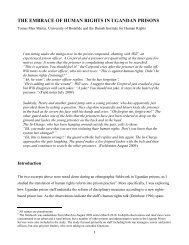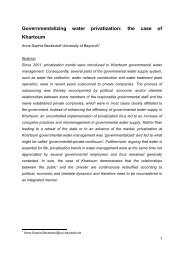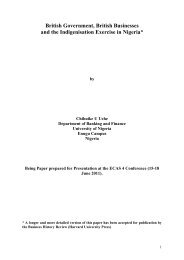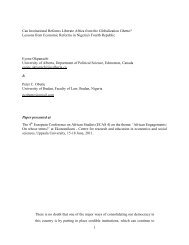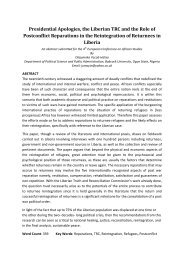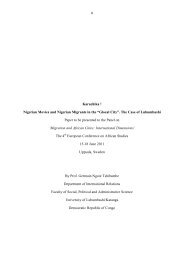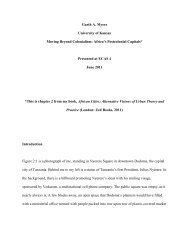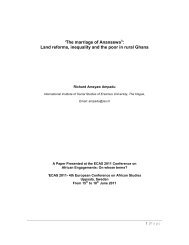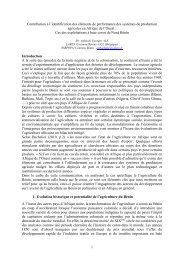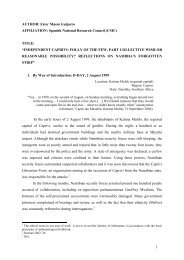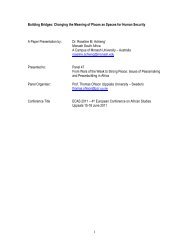Governance structures in informal settlements - The Nordic Africa ...
Governance structures in informal settlements - The Nordic Africa ...
Governance structures in informal settlements - The Nordic Africa ...
You also want an ePaper? Increase the reach of your titles
YUMPU automatically turns print PDFs into web optimized ePapers that Google loves.
Reg<strong>in</strong>a Fe<strong>in</strong> 1 and Christiane Kryck 1<br />
1. University of Bayreuth, Geography, Bayreuth, Germany<br />
<strong>Governance</strong> <strong>structures</strong> <strong>in</strong> <strong>in</strong>formal <strong>settlements</strong><br />
– A study of actors, aims and <strong>in</strong>struments <strong>in</strong> Addis Ababa<br />
First draft, please do not quote.<br />
Cities <strong>in</strong> the so-called develop<strong>in</strong>g countries are subject to <strong>in</strong>creas<strong>in</strong>g governance problems. One sign for weak<br />
control mechanisms seems to be the nearly ubiquitous <strong>in</strong>formality that concerns almost every area of life.<br />
Informality is also reflected <strong>in</strong> urban plann<strong>in</strong>g and becomes manifest <strong>in</strong> different forms of <strong>in</strong>formal hous<strong>in</strong>g,<br />
visibly encountered <strong>in</strong> slums and <strong>in</strong>formal <strong>settlements</strong>. But there is evidence that <strong>in</strong>formality is not to be<br />
equalised with a lack of governance <strong>structures</strong> and that <strong>in</strong>formal <strong>settlements</strong> are not free from control and<br />
steer<strong>in</strong>g mechanisms.<br />
In our paper we want to proof with empirical f<strong>in</strong>d<strong>in</strong>gs that <strong>in</strong>formal as well as even formal arrangements<br />
actually do exist and <strong>in</strong>tertw<strong>in</strong>e <strong>in</strong> <strong>in</strong>formal <strong>settlements</strong>. For this purpose we will present a case study carried<br />
out <strong>in</strong> Yerer, an <strong>in</strong>formal settlement at the south-eastern fr<strong>in</strong>ge of Addis Ababa, and identify the actors<br />
relevant for local governance systems, along with their aims and ambitions, resources and <strong>in</strong>struments.<br />
A range of actors have proven to be relevant for governance <strong>structures</strong> and processes <strong>in</strong> Yerer: First of all the<br />
<strong>in</strong>habitants of the <strong>in</strong>formal settlement themselves have structured and restructured the settlement pattern<br />
through the acquisition of plots and a variety of build<strong>in</strong>g activities. By appo<strong>in</strong>t<strong>in</strong>g a committee with<strong>in</strong> their<br />
fellow dwellers the <strong>in</strong>formal settlers furthermore succeeded already at an early stage to <strong>in</strong>fluence and<br />
control not only their respective pieces of land but also plann<strong>in</strong>g processes, spatial compositions and both<br />
technical and social <strong>in</strong>fra<strong>structures</strong> <strong>in</strong> the whole settlement. Also altogether formal actors and <strong>in</strong>stitutions <strong>in</strong><br />
the adm<strong>in</strong>istrative hierarchy of the city and the region of Addis Ababa put paid to completely uncontrolled<br />
development. In the case of <strong>in</strong>formal <strong>settlements</strong>, their <strong>in</strong>fluence is admittedly m<strong>in</strong>or to the <strong>in</strong>ternal forces<br />
but may not be neglected, notably not <strong>in</strong> the fields of dwellers’ registration and the provision of technical<br />
<strong>in</strong>frastructure. In this case, formal <strong>in</strong>stitutions and local authorities, and especially the relationship the<br />
<strong>in</strong>formal committee leaders have to them, even play a crucial role on the way to a potential formalisation of<br />
the settlement.<br />
<strong>The</strong> thesis of the urban crisis: <strong>in</strong>formal <strong>settlements</strong> as symptoms<br />
of urban disorder?<br />
Although some authors (e.g. BOCQUIER 2005:135, 140f., RAKODI 2006:53) po<strong>in</strong>t out that the <strong>in</strong>crease of urban<br />
population <strong>in</strong> sub-Saharan <strong>Africa</strong> has already slowed down, growth rates are still high <strong>in</strong> the big urban<br />
centres of the cont<strong>in</strong>ent (FEIN 2009:38f.). Due to the rapid growth go<strong>in</strong>g along with economic decl<strong>in</strong>e dur<strong>in</strong>g
the last decades contributors with<strong>in</strong> the literature on urbanisation <strong>in</strong> develop<strong>in</strong>g countries, and especially <strong>in</strong><br />
sub-Saharan <strong>Africa</strong>, came up with the term of the ”urban crisis” (e.g. TOSTENSEN & TVEDTEN & VAA 2001, STREN<br />
& HALFANI 2001:479) (cf. FEIN 2009:39). High land consumption, environmental problems like air pollution or<br />
deforestation, impacts on the health of dwellers and the collapse of local government <strong>structures</strong> are<br />
considered to be the problems form<strong>in</strong>g this ”crisis” (e.g. LOHNERT 2002:39, COY & KRAAS 2003:33, TOSTENSEN &<br />
TVEDTEN & VAA 2001:7) (cf. FEIN 2009:39). But urbanisation per se cannot and perhaps should not be<br />
considered as a problem, not even rapid urbanisation. <strong>The</strong> population growth <strong>in</strong> cities does not necessarily<br />
have negative outcomes and is regarded as fatal only <strong>in</strong> circumstances <strong>in</strong> which state and society fail to<br />
manage the consequences (cf. FEIN 2009:40, FANTU CHERU 2002:161, LOHNERT 2002:42). This leads to the<br />
question what exactly these mechanisms are that can prevent cities from disorder, chaos, or even anarchy.<br />
To answer this question we would like to give evidence us<strong>in</strong>g the example of <strong>in</strong>formal <strong>settlements</strong>, as it<br />
seems to be commonly assumed that the failure of local government <strong>structures</strong> and a lack of governance<br />
evidently occur <strong>in</strong> <strong>in</strong>formal <strong>settlements</strong> as places beyond any k<strong>in</strong>d of governmental or communal control.<br />
Given the fast urban population growth unaccompanied by economic growth and a gap between supply and<br />
demand <strong>in</strong> the urban hous<strong>in</strong>g stock, a big variety of residential areas evolved which can be subsumed as<br />
<strong>in</strong>formal <strong>settlements</strong> (cf. FEIN 2009:49, 55, MYERS & MURRAY 2007:17). <strong>The</strong>y are considered by LOHNERT<br />
(2002:47) as one of the most essential and most visible signs of rapid urbanisation <strong>in</strong> <strong>Africa</strong> (cf. also UN-<br />
HABITAT 2006:92) and contribute considerably to the enormous urban sprawl, the horizontal growth of<br />
<strong>Africa</strong>n cities (cf. FEIN 2009:49, FANTU CHERU 2002:163). In many cases, up to 50% of the urban sprawl derive<br />
from the growth of <strong>in</strong>formal <strong>settlements</strong> (DURAND-LASSERVE & ROYSTON 2002:3). GAEBE (2004:140) po<strong>in</strong>ts out<br />
that not only the poorest of the poor live <strong>in</strong> <strong>in</strong>formal <strong>settlements</strong>, similarly to FERNANDES & VARLEY (1998:5)<br />
who state that <strong>in</strong>formality and illegality <strong>in</strong> hous<strong>in</strong>g are not restricted to the urban poor (cf. FEIN 2009).<br />
Plac<strong>in</strong>g <strong>in</strong>formal hous<strong>in</strong>g <strong>in</strong> the complex field of legal issues<br />
<strong>The</strong>re is a cont<strong>in</strong>uum between formality and <strong>in</strong>formality. To spot a hous<strong>in</strong>g area on this range is difficult as<br />
<strong>in</strong>formal quarters exist <strong>in</strong> various, also country-specific forms. Moreover, formal and <strong>in</strong>formal, even legal and<br />
illegal elements can coexist, not only with<strong>in</strong> a settlement but even with<strong>in</strong> s<strong>in</strong>gular hous<strong>in</strong>g units (FEIN<br />
2009:62). Informality or illegality could refer to the purchase of the plot and/or the construction on the plot<br />
(GAEBE 2004:140). Informal <strong>settlements</strong> can be categorised along the legitimacy of land use <strong>in</strong>to two ma<strong>in</strong><br />
groups: Firstly squatter <strong>settlements</strong> on illegally occupied plots without the right to use the land at all, and<br />
secondly <strong>settlements</strong> on land which is not allocated for dwell<strong>in</strong>g purposes but is legally or at least semi-<br />
legally possessed by its owner (FEIN 2009:62). In addition, hous<strong>in</strong>g stock is considered <strong>in</strong>formal if it is<br />
constructed on declared build<strong>in</strong>g plots but does not fulfil the construction standards that apply for the<br />
particular built-up area, or if it lacks a formal build<strong>in</strong>g licence (FEIN 2009:62). UN-HABITAT (2003:112) numbers<br />
hous<strong>in</strong>g units constructed accord<strong>in</strong>g to applicable laws and regulations for the year 1996 at 48.6% <strong>in</strong> sub-<br />
Saharan <strong>Africa</strong>.
WUBALEM FEKADE (2000:131) as well as PAYNE & MAJALE (2004:53) additionally <strong>in</strong>troduce customary and<br />
<strong>in</strong>digenous tenure and emphasise that they often <strong>in</strong>terfere with each other. Furthermore, PAYNE (2002:13),<br />
UN-HABITAT (2003:4) and RAKODI (2006:66) dist<strong>in</strong>guish tenure between de jure (with legal land titles) and de<br />
facto, if the ownership of the build<strong>in</strong>g is recognised or if the plot is serviced by official authorities (FEIN<br />
2009:63). F<strong>in</strong>ally, legal titles for land or build<strong>in</strong>g <strong>structures</strong> can be issued <strong>in</strong>dividually or collectively (for a<br />
whole settlement, an association or – predom<strong>in</strong>antly <strong>in</strong> multi-storey residential build<strong>in</strong>gs – an owners<br />
corporation) (cf. FEIN 2009:63, PAYNE & MAJALE 2004:55). <strong>The</strong> documentation of tenure varies from full title<br />
deeds, over the verification by public utility bills, election records, tax vouchers and the like, to the non-<br />
existence of any documents (cf. FEIN 2009:63, UN-HABITAT 2006:94).<br />
For these reasons the question of legal titles for land and constructions is quite complex but plays a crucial<br />
role for the establishment of other steer<strong>in</strong>g mechanisms as it can be assumed that both dwellers and<br />
absentee landlords have a stronger <strong>in</strong>terest <strong>in</strong> support<strong>in</strong>g the <strong>in</strong>stalment of governance <strong>structures</strong>, be it<br />
formal or <strong>in</strong>formal ones, if risks of displacement, forced eviction and relocation are m<strong>in</strong>imised.<br />
In our case study of the <strong>in</strong>formal settlement of Yerer, we want to demonstrate that the <strong>in</strong>habitants recognise<br />
exactly these risks and act accord<strong>in</strong>gly by implement<strong>in</strong>g and adjust<strong>in</strong>g different <strong>in</strong>stitutions and mechanisms<br />
of governance. Hence they fill the presumed governance void us<strong>in</strong>g formal and <strong>in</strong>formal <strong>in</strong>stitutions based<br />
on their own actions us<strong>in</strong>g their own <strong>in</strong>struments and resources follow<strong>in</strong>g their own aims and ambitions.<br />
Informal <strong>settlements</strong> <strong>in</strong> Addis Ababa<br />
<strong>The</strong>re are different forms of <strong>in</strong>formal hous<strong>in</strong>g <strong>in</strong> Addis Ababa that comprise spontaneous <strong>settlements</strong> <strong>in</strong> the<br />
<strong>in</strong>ner-city, regular residential areas with <strong>in</strong>formal hous<strong>in</strong>g development and peripheral spontaneous<br />
<strong>settlements</strong> (cf. FEIN 2009:201). <strong>The</strong>ir characteristics differ concern<strong>in</strong>g their location, their formation, their<br />
tenure status, their impact on urban development and their appearance as table 1 <strong>in</strong>dicates. In the eyes of<br />
the government only <strong>settlements</strong> belong<strong>in</strong>g to the third category are seen as “<strong>in</strong>formal <strong>settlements</strong>” and<br />
also the case study area of Yerer belongs to this group. <strong>The</strong>refore, the follow<strong>in</strong>g remarks on <strong>in</strong>formal<br />
<strong>settlements</strong> <strong>in</strong> Addis Ababa will solely concentrate on this category.<br />
TABLE 1 THE DIFFERENT FORMS OF INFORMAL HOUSING IN ADDIS ABABA<br />
Spontaneous <strong>settlements</strong><br />
<strong>in</strong> the <strong>in</strong>ner-city<br />
Location Located <strong>in</strong> the older and<br />
<strong>in</strong>ner-city areas.<br />
Formation Built by land speculators<br />
dur<strong>in</strong>g the imperial time<br />
and developed and<br />
further congested after<br />
nationalisation. Today <strong>in</strong> a<br />
precarious condition.<br />
Regular residential areas<br />
with <strong>in</strong>formal hous<strong>in</strong>g<br />
development<br />
Scattered throughout the<br />
city.<br />
Formation through<br />
<strong>in</strong>formal constructions <strong>in</strong><br />
regular residential areas<br />
and through private land<br />
owners who transformed<br />
small attached and<br />
Peripheral spontaneous<br />
<strong>settlements</strong><br />
Located at the urban fr<strong>in</strong>ges<br />
and expansion areas<br />
border<strong>in</strong>g predom<strong>in</strong>antly<br />
rural areas.<br />
Built <strong>in</strong>formally on land due<br />
to lack of land titles.<br />
Formation s<strong>in</strong>ce the end of<br />
the socialist regime, but<br />
accelerated s<strong>in</strong>ce 1991.
Tenure status Land and houses belong <strong>in</strong><br />
most cases to the<br />
government (so called<br />
Impact on urban<br />
development<br />
Kebele houses).<br />
Congestion is the ma<strong>in</strong><br />
impact and <strong>in</strong>tense<br />
burden on exist<strong>in</strong>g<br />
<strong>structures</strong>.<br />
Appearance Regular build<strong>in</strong>g<br />
extensions and high<br />
congestion.<br />
Predom<strong>in</strong>antly low quality<br />
mud huts and lack of<br />
<strong>in</strong>frastructure (sewerage,<br />
latr<strong>in</strong>es, fresh water,<br />
roads etc.)<br />
detached houses <strong>in</strong>to<br />
rental accommodations.<br />
Partly governmental<br />
partly private ownership.<br />
Also congestion and<br />
<strong>in</strong>tense burden on urban<br />
services, for <strong>in</strong>stance.<br />
Also predom<strong>in</strong>antly mud<br />
huts but dilapidat<strong>in</strong>g and<br />
highly congested.<br />
Infrastructure is<br />
overloaded or deficient.<br />
Source: KRYCK 2006:55, modified after DEMISSACHEW SHIFERAW (2000:83)<br />
Land is legally belong<strong>in</strong>g to<br />
the state and disputes are<br />
common.<br />
Expansion of urban area and<br />
relief of <strong>in</strong>ner-city<br />
congestion. Uncontrolled<br />
extension.<br />
Are still mostly sparsely<br />
populated compared to the<br />
others. Predom<strong>in</strong>antly one<br />
room mud huts which lack<br />
any basic <strong>in</strong>frastructure.<br />
Informal <strong>settlements</strong> started to develop <strong>in</strong> the late 1980s, when peasants at the urban fr<strong>in</strong>ge expected that<br />
the government might confiscate their land for city expansion and started to subdivide their plots, which was<br />
not illegal, as long as land was used for agricultural purposes and not transformed <strong>in</strong>to urban land (FEIN<br />
2009:201, KRYCK 2006:56, KALKIDAN BAINESAGNE 2001:57ff.).<br />
Like <strong>in</strong> many other <strong>Africa</strong>n cities, the <strong>in</strong>formal <strong>settlements</strong> were not connected to water supply and the<br />
households usually rely on private vendors when public taps are miss<strong>in</strong>g. <strong>The</strong>y were also not connected to<br />
sewerage systems, and any k<strong>in</strong>d of land preparation (e.g. by dra<strong>in</strong>age systems) before construction has taken<br />
place. However, <strong>in</strong>formal households <strong>in</strong> Yerer were mostly supplied with electricity, which was quite<br />
astonish<strong>in</strong>g, as the electricity provider is a state-owned enterprise (FEIN 2009, KRYCK 2006).<br />
At the time when our study was carried out, the most important regulation on <strong>in</strong>formal <strong>settlements</strong><br />
conta<strong>in</strong>ed two ma<strong>in</strong> parts: <strong>The</strong> first one was deal<strong>in</strong>g with <strong>in</strong>formally built houses before 1996 and revealed<br />
that these houses can be formalised if residential use <strong>in</strong> this location is accord<strong>in</strong>g to the Master Plan of 2001.<br />
Plots of up to 175 m² should be issued on the basis of a lease arrangement and bigger plots should be<br />
reduced to the size of 175 m², if possible, and either the surplus of land should have been confiscated by the<br />
government or the owner should have paid sanctions (cf. FEIN 2009:201, KRYCK 2006:59). If the land was not<br />
located <strong>in</strong> a `residential area´ accord<strong>in</strong>g to the Master Plan the <strong>in</strong>habitant would have received<br />
compensatory land of up to 150m² <strong>in</strong> another part of the capital. At first glance this seemed to be very<br />
beneficial to the <strong>in</strong>formal settlers, but some of the <strong>in</strong>formal <strong>settlements</strong> (like Yerer) were not located <strong>in</strong><br />
designated `residential´ but <strong>in</strong> `green areas´ (see ORAAMP 2000:37, 49). So, they were aga<strong>in</strong>st the Master<br />
Plan and had to be evicted by compensat<strong>in</strong>g the dwellers. <strong>The</strong>re emerged the second problem, because<br />
people had to proof that they had started to live there before 1996 and nobody guaranteed that the<br />
compensated land would be well located (cf. KRYCK 2006:60). <strong>The</strong> second part of the regulation concerned<br />
the houses built between 1996 and 2002. In order to guarantee a planned development of the city, these
<strong>settlements</strong> should have been evicted, while the <strong>in</strong>habitants as a group should receive compensatory land as<br />
a cooperative. All <strong>in</strong>formal houses built after 2002 would have been demolished without any compensation<br />
(ibid.).<br />
Actors, aims and <strong>in</strong>struments <strong>in</strong> Yerer<br />
<strong>The</strong> <strong>in</strong>formal settlement of Yerer, located <strong>in</strong> the south-eastern part of Addis Ababa <strong>in</strong> Bole sub-city,<br />
developed on the land of eight peasants. Until 1983 the area on the mounta<strong>in</strong> slope was <strong>in</strong>habited by these<br />
farmers and used as graz<strong>in</strong>g land for their cattle (FEIN 2009:201f., KALKIDAN BAINESAGNE 2001:115). In the<br />
follow<strong>in</strong>g 17 years, the land transformation process started slowly with the arrival of 11 urban dwellers,<br />
search<strong>in</strong>g for affordable plots. With <strong>in</strong>creas<strong>in</strong>g demand for urban land and after the political upheaval and<br />
change of government <strong>in</strong> the early 1990s, more and more <strong>in</strong>terested people came to settle <strong>in</strong> Yerer (2000:<br />
238 plots; 2006: 365 plots) (cf. KRYCK 2006:65, KALKIDAN BAINESAGNE 2001). <strong>The</strong> ma<strong>in</strong> reason for the peasants’<br />
will<strong>in</strong>gness to subdivide and sell the land was the experience, that their neighbour<strong>in</strong>g farmers were displaced<br />
and <strong>in</strong>adequately compensated <strong>in</strong> order to vacate the area for urban development. After they predicted this<br />
to happen to themselves <strong>in</strong> the future, they sold out nearly their whole land, especially after parts on the<br />
mounta<strong>in</strong> plateau were taken for formal residential development (cf. FEIN 2009:201, KRYCK 2006:66, KALKIDAN<br />
BAINESAGNE 2001:117).<br />
By 2006, the area was already consolidated and densely populated, while only few, mostly steep, locations<br />
were left open. By this time an estimated number of 1000 households lived on the 365 plots (FEIN 2009:20,<br />
KRYCK 2006:65).<br />
<strong>The</strong> most important actors responsible for land transformation and restructur<strong>in</strong>g were identified as the<br />
dwellers themselves, the local committee they have formed and the official city adm<strong>in</strong>istration. <strong>The</strong>ir<br />
activities, aims and ambitions, resources and <strong>in</strong>struments will be identified <strong>in</strong> the follow<strong>in</strong>g, based on<br />
f<strong>in</strong>d<strong>in</strong>gs from a study carried out by the authors from 2006 to 2009 <strong>in</strong> Addis Ababa (FEIN 2009:155ff., KRYCK<br />
2006).<br />
<strong>The</strong> dwellers<br />
<strong>The</strong> <strong>in</strong>habitants are clearly the central actors of spatial restructur<strong>in</strong>g through the acquisition of plots and the<br />
construction of houses for own <strong>in</strong>habitancy or tenancy. <strong>The</strong>refore, they can be considered as the producers<br />
and consumers of hous<strong>in</strong>g. In order to acquire the f<strong>in</strong>ancial means for construction, many plot owners<br />
subdivided their land and sold it, result<strong>in</strong>g <strong>in</strong> further densification of the area. <strong>The</strong> construction process is,<br />
like <strong>in</strong> most other <strong>in</strong>formal <strong>settlements</strong>, dom<strong>in</strong>ated by <strong>in</strong>cremental progress, i.e. a first room is constructed,<br />
followed by fenc<strong>in</strong>g and step by step expansion and improvement of the unit.<br />
<strong>The</strong> ma<strong>in</strong> objective of this group is to have access to hous<strong>in</strong>g that is socio-culturally and f<strong>in</strong>ancially adequate<br />
and is backed by secure tenure (FEIN 2010, FEIN 2009). <strong>The</strong> available f<strong>in</strong>ancial resources of the respective<br />
household determ<strong>in</strong>e the adequacy of the house, while the dwellers utilised the <strong>in</strong>strument of establish<strong>in</strong>g a
local committee to achieve formalisation of land and access to basic <strong>in</strong>frastructure. Before illustrat<strong>in</strong>g the<br />
organisational forms <strong>in</strong> the settlement, we would like to raise the question, who these dwellers are.<br />
To answer this question briefly can contribute to an understand<strong>in</strong>g of available resources and <strong>in</strong>struments<br />
for achiev<strong>in</strong>g <strong>in</strong>dividual and collective objectives. <strong>The</strong> households covered by our survey <strong>in</strong> 2006, consisted of<br />
4.2 persons on average (FEIN 2009:225, KRYCK 2006:89). Most families could be considered as nuclear<br />
families, while only very few offered permanent shelter to other relatives (FEIN 2009:231, KRYCK 2006:89).<br />
Only 13% of all <strong>in</strong>terviewees were born <strong>in</strong> Addis Ababa, <strong>in</strong>dicat<strong>in</strong>g that rural-urban migration and new<br />
household formation are the ma<strong>in</strong> drivers of <strong>in</strong>formal growth. Densification and rapid growth took place<br />
especially between 2001 and 2005, s<strong>in</strong>ce 58% of the <strong>in</strong>terviewed households moved to Yerer <strong>in</strong> this period.<br />
<strong>The</strong> <strong>in</strong>crease of the number of tenants dur<strong>in</strong>g this time contributed significantly to the population <strong>in</strong>crease,<br />
while nearly none such arrangements had existed before 2000 (FEIN 2009:206, KRYCK 2006:93). <strong>The</strong> average<br />
<strong>in</strong>come per household <strong>in</strong> 2006 was 478 Birr (equivalent to USD 54.6 or 43.6 Euro <strong>in</strong> 2006) per month, while<br />
half of the households earned <strong>in</strong>comes below 400 Birr (FEIN 2009:251, KRYCK 2006:90). <strong>The</strong>se <strong>in</strong>comes are<br />
mostly generated <strong>in</strong> the <strong>in</strong>formal sector (81% were self-employed or employed <strong>in</strong>formally) and most<br />
considered themselves as casual labourers rely<strong>in</strong>g on irregular and fluctuat<strong>in</strong>g <strong>in</strong>comes (FEIN 2009:248ff.,<br />
KRYCK 2006:90f.). Those rema<strong>in</strong><strong>in</strong>g 19% of households, who relied on <strong>in</strong>comes from formal occupation,<br />
comprise a very heterogeneous group of doctors, teachers, <strong>in</strong>dustrial workers, taxi or bus drivers.<br />
In order to adjust to irregular <strong>in</strong>comes many house owners use their plots for <strong>in</strong>come generat<strong>in</strong>g activities,<br />
hence contribut<strong>in</strong>g to further densification but also to diversification of services and facilities. Examples for<br />
on-plot <strong>in</strong>come generation are the construction and lett<strong>in</strong>g of rental units, the construction and runn<strong>in</strong>g of<br />
m<strong>in</strong>i-shops, bars, barbershops, bakeries or other food process<strong>in</strong>g activities (FEIN 2009:248ff., KRYCK<br />
2006:101ff.). <strong>The</strong> result of Yerer’s development from a formerly rural area to an urbanised settlement is the<br />
presence of urban agricultural activities and different forms of livestock breed<strong>in</strong>g (FEIN 2009:203). <strong>The</strong>se<br />
activities, however, are decl<strong>in</strong><strong>in</strong>g and some farmers have already replaced urban agriculture with the<br />
construction of rental units, s<strong>in</strong>ce <strong>in</strong>comes from rent are regular, reliable and far more profitable. <strong>The</strong>refore,<br />
it is not surpris<strong>in</strong>g that the number of tenants <strong>in</strong>creased tenfold between 2001 and 2006, pay<strong>in</strong>g an average<br />
rent of 55 Birr <strong>in</strong> 2006 (FEIN 2009:206). Absentee landlords are, however, still unusual, most landlords live on<br />
the same plot and often use the same basic facilities as their tenants.<br />
This proves that the <strong>in</strong>habitants are <strong>in</strong>tegrated <strong>in</strong>to economic systems and therefore <strong>in</strong> a consolidated<br />
<strong>in</strong>stitutional sett<strong>in</strong>g, which comprise, particularly <strong>in</strong> the sub-Saharan context, traditional community<br />
associations (cf. FEIN 2009:90ff.). In the case of Ethiopia these are especially known as Iddir und Iqub (FEIN<br />
2009:182). An Iddir is an association formed by work colleagues, members of the same ethnic or religious<br />
group, or <strong>in</strong>habitants of the same residential area. <strong>The</strong> ma<strong>in</strong> purpose of an Iddir is to provide f<strong>in</strong>ancial and<br />
material support for its members, orig<strong>in</strong>ally <strong>in</strong> the case of a funeral or a wedd<strong>in</strong>g but also follow<strong>in</strong>g<br />
unforeseen events. Many neighbourhood-Iddirs thus operate <strong>in</strong> a wide range and file petitions with public<br />
authorities, take care of the supply with technical and social <strong>in</strong>frastructure, or even engage <strong>in</strong> hous<strong>in</strong>g
construction, for example if a member is physically unable and <strong>in</strong> need of help (FEIN 2009:182, KRYCK<br />
2006:107). Iqubs are the Ethiopian form of rotat<strong>in</strong>g sav<strong>in</strong>gs and credit associations. <strong>The</strong>ir members meet<br />
regularly and contribute a certa<strong>in</strong> amount of money to a community coffer which is then distributed to one<br />
person who has been chosen by lot. For the case that a member is <strong>in</strong> great need of immediate f<strong>in</strong>ancial<br />
support, the saved amount can be allocated without the lottery if the other members agree. Usually the<br />
money is meant to be used for bus<strong>in</strong>ess <strong>in</strong>vestments or private expenditures but <strong>in</strong> some cases is spent for<br />
build<strong>in</strong>g dwell<strong>in</strong>gs or their service supply (FEIN 2009:186f.).<br />
<strong>The</strong> dwellers’ committee<br />
With the population <strong>in</strong>crease s<strong>in</strong>ce the early 1990s and the related process of densification, the <strong>in</strong>habitants<br />
themselves recognised the need for a planned development, s<strong>in</strong>ce proper access to some <strong>in</strong>dividual plots<br />
became difficult (KALKIDAN BAINESAGNE 2001:140). <strong>The</strong>refore, they founded a committee responsible for the<br />
development of the settlement as a whole <strong>in</strong> 1996, by elect<strong>in</strong>g eight members from the community. <strong>The</strong> first<br />
activity carried out was the development of a road network that would even allow for motor vehicles to<br />
access the settlement and those plots, that aren’t located at steep slopes. <strong>The</strong> active regulation of the<br />
alleged uncontrolled settlement growth was the result. <strong>The</strong> <strong>in</strong>habitants themselves gathered <strong>in</strong> order to<br />
construct the roads of 6, 8, 10 or 12 meters width, while some plot owners had to give up some square<br />
meters <strong>in</strong> order to make space for road construction (FEIN 2009:201ff., KRYCK 2006:105).<br />
In the further process of consolidation, the committee undertook the tasks of provid<strong>in</strong>g the <strong>in</strong>habitants with<br />
basic <strong>in</strong>frastructure, like the connection to the power grid or to the telephone network and engaged <strong>in</strong><br />
further transportation <strong>in</strong>frastructure projects, such as build<strong>in</strong>g and ma<strong>in</strong>ta<strong>in</strong><strong>in</strong>g bridges, that connect the<br />
settlement to the city. Whenever f<strong>in</strong>ancial sources were needed, the committee members advertised the<br />
need and benefits of the proposed activities and collected the money among the <strong>in</strong>habitants. <strong>The</strong><br />
committee, therefore, became the contract<strong>in</strong>g party <strong>in</strong> the name of the <strong>in</strong>habitants and dealt with municipal<br />
service providers. <strong>The</strong>y took over responsibilities that would conventionally be part of the urban<br />
adm<strong>in</strong>istrative bodies (FEIN 2009:201ff.).<br />
<strong>The</strong> most prom<strong>in</strong>ent aim of the committee was the preparation of reliable <strong>structures</strong> that would be<br />
conducive for formalisation of the settlement. <strong>The</strong>y wanted to achieve a universally accepted settlement<br />
structure and were work<strong>in</strong>g on the ma<strong>in</strong>tenance, repair and supply of technical, social and economic<br />
<strong>in</strong>frastructure. <strong>The</strong> <strong>in</strong>struments available to the committee <strong>in</strong> order to fulfil its tasks were the formulation<br />
and the control of construction rules, the budget<strong>in</strong>g and money collection for <strong>in</strong>frastructure projects, social<br />
control and close personal contacts to the local adm<strong>in</strong>istration. In the last years, the committee had been<br />
highly successful <strong>in</strong> lobby<strong>in</strong>g for public water wells <strong>in</strong> the settlement, where water supply had been one of<br />
the major problems for the community. Furthermore, the committee was effectively advocat<strong>in</strong>g for the<br />
recognition of Yerer’s orderly development through the local adm<strong>in</strong>istration, and f<strong>in</strong>ally the area was<br />
formalised dur<strong>in</strong>g a citywide campaign (FEIN 2009:201, 205).
<strong>The</strong> Kebele adm<strong>in</strong>istration<br />
<strong>The</strong> public adm<strong>in</strong>istration body called Kebele <strong>in</strong> the urban Ethiopian context had only m<strong>in</strong>or <strong>in</strong>fluence on the<br />
settlement’s development until formalisation. Kebele could be translated as neighbourhood council or<br />
community association and represents the lowest adm<strong>in</strong>istrative level (FEIN 2009:159). <strong>The</strong> concept was<br />
developed dur<strong>in</strong>g the so-called Derg-regime, declared to be Marxist-Len<strong>in</strong>ist, under the rule of colonel<br />
Mengistu Haile Mariam from 1974 to 1991 as the urban counterpart to the rural Peasants’ Associations and<br />
all citizens had to be registered <strong>in</strong> either one of them(FEIN 2009:159, KRYCK 2006:67). <strong>The</strong> basic objectives of<br />
the Kebeles are to regulate and control local developments on the basis of municipal requirements and<br />
plans, and to fulfil all duties and services related to the local adm<strong>in</strong>istrative level. In order to achieve these<br />
aims, the Kebele councils refer to the <strong>in</strong>struments of laws and regulations and exercise executive power.<br />
Hence, the responsibilities of the Kebele council are to control any development <strong>in</strong> their very territorial<br />
entity, e.g. by forced deconstruction. However, an active <strong>in</strong>tervention <strong>in</strong> governance and control of<br />
settlement <strong>structures</strong> was generally rare, s<strong>in</strong>ce the Kebeles as the lowest adm<strong>in</strong>istrative unit were not <strong>in</strong><br />
charge of implement<strong>in</strong>g superord<strong>in</strong>ate directives of urban plann<strong>in</strong>g. This was also the case <strong>in</strong> Yerer, where<br />
most <strong>in</strong>habitants only had to deal with the Kebele adm<strong>in</strong>istration <strong>in</strong> order to acquire their ID cards or to pay<br />
taxes on property. Especially this engagement <strong>in</strong> tax collection caused irritation among the <strong>in</strong>formal<br />
dwellers, s<strong>in</strong>ce they perceived the payments as quasi-recognition of their tenure status. On the other hand,<br />
the Kebele had to be consulted <strong>in</strong> case of sell<strong>in</strong>g and buy<strong>in</strong>g plots, and their agreement was necessary <strong>in</strong> case<br />
of any planned construction. So the Kebele engaged <strong>in</strong> <strong>in</strong>formal processes of land acquisition, sale and<br />
construction, and therefore ironically contributed to the <strong>in</strong>formalisation of governance <strong>structures</strong> (e.g. GAEBE<br />
2004:307f.) <strong>in</strong>stead of enforc<strong>in</strong>g formal <strong>in</strong>stitutions.<br />
Summary and conclusion<br />
Summ<strong>in</strong>g up, the three described actors have formed networks and susta<strong>in</strong>ed relations both with<strong>in</strong> the<br />
settlement and with external actors like various authorities responsible for <strong>in</strong>frastructure supply. <strong>The</strong><br />
<strong>in</strong>habitants as the ma<strong>in</strong> group of <strong>in</strong>ternal actors <strong>in</strong> governance processes are often organised <strong>in</strong> the so-called<br />
Iddir groups. Out of the <strong>in</strong>habitants, representatives were elected dur<strong>in</strong>g community meet<strong>in</strong>gs, who form<br />
the committee deal<strong>in</strong>g with local decision-mak<strong>in</strong>g and controll<strong>in</strong>g the spatial development <strong>in</strong> Yerer. Its<br />
chairman himself is also a member of the Kebele council, where he is able to <strong>in</strong>fluence decisions beneficiary<br />
for the settlement. <strong>The</strong> committee dealt directly with the Water Authority, the Electrical Light and Power<br />
Authority as well as with the Road Authority <strong>in</strong> order to represent the needs of the <strong>in</strong>habitants more<br />
effectively. It therefore acts as stakeholder for the community’s <strong>in</strong>terests, but also exercises control with<strong>in</strong><br />
the settlement.<br />
Despite the apparent disorder and lack of control <strong>in</strong> <strong>in</strong>formal <strong>settlements</strong> (as mentioned <strong>in</strong> the beg<strong>in</strong>n<strong>in</strong>g),<br />
the case of Yerer proves <strong>in</strong>deed that a number of various <strong>in</strong>stitutions do form sophisticated governance<br />
<strong>structures</strong>. F<strong>in</strong>ally we would like to raise the question whether formality itself results <strong>in</strong> more effective
control mechanisms. From our po<strong>in</strong>t of view the effect of formality is irrelevant: Well established <strong>in</strong>formal<br />
<strong>in</strong>stitutions have considerably facilitated the formalisation process <strong>in</strong> Yerer because they could easily be<br />
<strong>in</strong>tegrated <strong>in</strong>to the formal sett<strong>in</strong>g of urban governance, but conversely this case shows that formal<br />
<strong>structures</strong> are not a precondition at all for strong governance <strong>structures</strong>.<br />
Bibliography<br />
BAINESAGNE, KALKIDAN see KALKIDAN BAINESAGNE<br />
BOCQUIER, PHILIPPE (2005): Analyz<strong>in</strong>g urbanization <strong>in</strong> sub-Saharan <strong>Africa</strong>. In: CHAMPION, TONY & HUGO, GRAEME<br />
(Ed.): New forms of urbanization. Beyond the urban-rural dichotomy. Aldershot, p.199-150.<br />
CHERU, FANTU see FANTU CHERU<br />
COY, MARTIN & KRAAS, FRAUKE (2003): Probleme der Urbanisierung <strong>in</strong> den Entwicklungslaendern. In:<br />
Petermanns Geographische Mitteilungen 147(1), p. 32-41.<br />
DEMISSACHEW SHIFERAW (2000): Wohnungsentwicklung <strong>in</strong> regulaeren Unterschichtquartieren <strong>in</strong> Addis Abeba,<br />
Aethiopien. Bauliche, typologische und soziooekonomische Untersuchung. Karlsruhe.<br />
DURAND-LASSERVE, ALAIN & ROYSTON, LAUREN (2002): International trends and country contexts. From tenure<br />
regularization to tenure security. In: DURAND-LASSERVE, ALAIN & ROYSTON, LAUREN (Ed.): Hold<strong>in</strong>g their<br />
ground. Secure land tenure for the urban poor <strong>in</strong> develop<strong>in</strong>g countries. London/Sterl<strong>in</strong>g, p. 1-34.<br />
FANTU CHERU (2002): <strong>Africa</strong>n renaissance. Roadmaps to the challenge of globalization. New York/London.<br />
FEIN, REGINA (2009): Urbane Wohnraumversorgung <strong>in</strong> Subsahara-Afrika. E<strong>in</strong> analytisches Modell und se<strong>in</strong>e<br />
Anwendung am Beispiel Addis Abeba. Saarbruecken.<br />
FEIN, REGINA (2010): Angemessenheit von Wohnraum. Normative Konzeption, der Versuch e<strong>in</strong>er Def<strong>in</strong>ition<br />
und Erlaeuterungen am Fallbeispiel Addis Abeba. In: DITTMANN, ANDREAS & JUERGENS, ULRICH (Ed.):<br />
Tansformationsprozesse <strong>in</strong> afrikanischen Entwicklungsländern. Berl<strong>in</strong>, p. 165-178.<br />
FEKADE, WUBALEM see WUBALEM FEKADE<br />
FERNANDES, EDÉSIO & VARLEY, ANN (1998): Law, the city and citizenship <strong>in</strong> develop<strong>in</strong>g countries. An<br />
<strong>in</strong>troduction. In: FERNANDES, EDÉSIO & VARLEY, ANN (Ed.): Illegal cities. Law and urban change <strong>in</strong><br />
develop<strong>in</strong>g countries. London/New York, p. 3-17.<br />
GAEBE, Wolf (2004): Urbane Raeume. Stuttgart.<br />
KALKIDAN BAINESAGNE (2001): Informal land transformation at the urban fr<strong>in</strong>ge of Addis Ababa. Trondheim.<br />
Unpublished Master <strong>The</strong>sis.<br />
KRYCK, CHRISTIANE (2006): Informal <strong>settlements</strong> as a response to the hous<strong>in</strong>g crisis <strong>in</strong> Addis Ababa. <strong>The</strong> case of<br />
Yerer. Bayreuth. Unpublished Master <strong>The</strong>sis.<br />
LOHNERT, BEATE (2002): Vom Huettendorf zur Eigenheimsiedlung. Selbsthilfe im staedtischen Wohnungsbau.<br />
Ist Kapstadt das Modell fuer das Neue Suedafrika? Osnabrueck (Osnabruecker Studien zur<br />
Geographie 24).<br />
MYERS, GARTH A. & MURRAY, MARTIN J. (2007): Situat<strong>in</strong>g contemporary cities <strong>in</strong> <strong>Africa</strong>. In: MYERS, GARTH A. &<br />
MURRAY, MARTIN J. (Hg.): Cities <strong>in</strong> contemporary <strong>Africa</strong>. New York, p. 1-25.<br />
OFFICE FOR THE REVISION OF THE ADDIS ABABA MASTER PLAN (ORAAMP) (2000): City development plan. Addis<br />
Ababa.<br />
PAYNE, GEOFFREY (2002): Introduction. In: PAYNE, GEOFFREY (Hg.): Land, rights and <strong>in</strong>novation. Improv<strong>in</strong>g tenure<br />
security for the urban poor. London. S. 3-22.
PAYNE, GEOFFREY & MAJALE, MICHAEL (2004): <strong>The</strong> urban hous<strong>in</strong>g manual. Mak<strong>in</strong>g regulatory frameworks work<br />
for the poor. London/Sterl<strong>in</strong>g.<br />
RAKODI, CAROLE (2006): <strong>The</strong> urban challenge <strong>in</strong> <strong>Africa</strong>. In: KEINER, MARCO & KOLL-SCHRETZENMAYR, MARTINA &<br />
SCHMID, WILLY A. (Hg.): Manag<strong>in</strong>g urban futures. Susta<strong>in</strong>ability and urban growth <strong>in</strong> develop<strong>in</strong>g<br />
countries. Aldershot et al. S. 47-70.<br />
SHIFERAW, DEMISSACHEW see DEMISSACHEW SHIFERAW<br />
STREN, RICHARD & HALFANI, MOHAMED (2001): <strong>The</strong> cities of sub-Saharan <strong>Africa</strong>. From dependency to<br />
marg<strong>in</strong>ality. In: PADDISON, RONAN (Hg.): Handbook of urban studies. London et al. S. 466-485.<br />
TOSTENSEN, ARNE & TVEDTEN, INGE & VAA, MARIKEN (2001): <strong>The</strong> urban crisis, governance and associational life.<br />
In: TOSTENSEN, ARNE & TVEDTEN, INGE & VAA, MARIKEN (Hg.): Associational life <strong>in</strong> <strong>Africa</strong>n cities. Popular<br />
responses to the urban crisis. Uppsala. S. 7-26.<br />
UNITED NATIONS HABITAT (2003): <strong>The</strong> challenge of slums. Global report on human <strong>settlements</strong> 2003. London.<br />
UNITED NATIONS HABITAT (2006): <strong>The</strong> state of the world’s cities report 2006/2007. <strong>The</strong> Millennium<br />
Development Goals and urban susta<strong>in</strong>ability: 30 years of shap<strong>in</strong>g the Habitat Agenda. Nairobi.<br />
WUBALEM FEKADE (2000): Deficits of formal urban land management and <strong>in</strong>formal responses under rapid<br />
urban growth. An <strong>in</strong>ternational perspective. In: Habitat International 24, S. 127-150.




